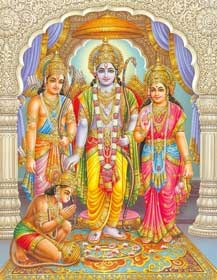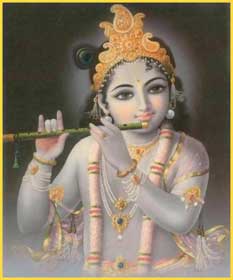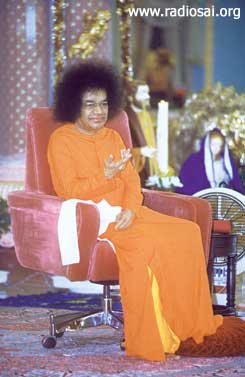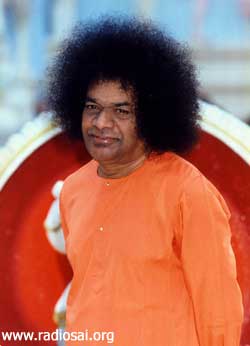 |
 |
 |
 |
| Volume 4 - Issue 11 NOVEMBER 2006 |
|
| CONVERSATIONS WITH SAI PART 26 |
H: Sometimes Swami speaks of the Ramayana and the Mahabharata as if they were historical, and sometimes as if they were to be taken as representative of every individual's inner conflicts, virtues, bad qualities, etc. Are these events and people historical fact? Sai: Yes, they are a record of historical people and incidents. But in themselves, the battles and troubles of these families are unimportant. What is of lasting significance is the inner spiritual significance of the happening. Rama was a real person and an Avatar and Dasaratha was His father. Krishna was real and the events of His Avatara were real. Rama's life, over the ages, has been altered and distorted somewhat, and Swami's story of Rama will be a classic through several Yugas. In the time of Krishna, the viewpoint was different, and actions occurred that would be viewed in a different light today.
Sai: The Yakshas were called demons, but even they prostrated before Rama when they perceived His charming face and figure. The Yakshas had deformed faces. Sometimes the nose was missing. Sometimes the eyes were very deeply set.
Sai: No. By the power of mantra the plane would fly. Mantras were also used to shoot arrows. The arrows were worshipped to make them effective. When Arjuna heard of Krishna's death, he forgot all mantras and was powerless. Today, at the festival of Navarathri, the farmers worship their farm implements with mantra and that has an effect. H: Then even today, mantras still have effect? Sai: Oh, yes. Even Westerners who experiment with the Gayatri mantra find it has power. The mantra should be said by a person well practiced in spiritual life. H: Swami does not seem to give out mantras. When His devotees are ready for mantra should they ask Swami, or will He say when they are ready? Sai: Mantras now are given out by low persons, the head of a Mutt here and there, some yogi, and so on. Avatars have never given mantras. The Avatar shows that God is everywhere. The recitation of a mantra is narrow-minded. In the time of an Avatar, to hear him, to understand what he says and do it is a mantra. Krishna gave no mantra to the Pandava brothers, not even to Arjuna. He simply said, “Do this, do that.” This was enough and the action was very powerful. H: Baba's teaching carries the ring of truth and His words carry into action almost by themselves. Their authority does not even depend on whether Swami is an Avatar or not.
H: If Arjuna had kept the feeling and concept of Krishna in his heart, would he have retained his strength? Sai: When he heard that Krishna had died, he lost all interest in the world. H: The Gopis were overcome with grief when Krishna departed from there. They must have had Him in their hearts. Sai: At the news of Krishna's death, a number of the Gopis fell lifeless from shock. H: Then their relationship was only with the form of Krishna? Sai: The Gopis had both relationships. Because of their years of close companionship with Krishna, they were strongly attached to Krishna's physical presence. But they also were knowing Krishna in their hearts. They always felt He was with them, even when His worldly activity had taken Him far away. H: Then why the terrible shock, if Krishna was so firmly known in the heart? Sai: The Gopis had no interest in the world and the body once Krishna was dead. Their only reason for placing any value on their physical existence was because Krishna was also in physical existence. Their hearts were completely pure, and Krishna was their heart. The physical bond was also strong. For example, you have proof that Swami is always with you, but at the same time, you wish to come to India to be near Swami, isn't it? H: It seems to me that this episode of Arjuna and the death of Krishna carries a very important lesson for us who live today. Sai: There is no need to take Arjuna as a model. Just realize that God is with you and in your heart at all times. H: Might an Avatar be born in some other part of the world? Sai: Buddha, Christ, Mohammed and others were not Avatars. They had some divine power. Only in India are Avatars born, because only in India are the Sastras understood. And only in India do the sages constantly experiment and practice. It is like in a gold mine. Where gold is found, there gather the geologists, engineers, and experienced miners. The gold is mined there, and then it is taken all over the world.
Sai: (Laughs) It changes the picture a great deal. If the Lord is one's guru, no need to worry about anything. Just as a loving mother cares for her child, if one has surrendered his life to God with full faith in Him, the Lord takes care of that devotee. No need to worry about anything. Really, guru is only God. God is within only. Those outside are not gurus. They are teachers of one sort or another. Guru means, “He who removes darkness.” Only God can remove the darkness within; only God's grace. H: In this business of sadhana, why is it not possible from the very start to take the Lord as guru and surrender one's life to Him? Sai: (Again laughing) That is not so easy! Very difficult to do. First one needs to tame the mind. It is just like a wild elephant in the forest. It must be caught and tamed. Once subdued and tamed, it is like an elephant in a circus who can be made to sit on a small stool by a small boy. And that is the result of training and practice.
Sai: The proper course is for that person to admit that he does not know God, and to suggest that he and his followers jointly investigate and practice sadhana. But they do not do that. The idea is to pick up an answer here and an answer there, then give out the information like a phonograph recording, pretending it is their own wisdom. One such person has a son over whom he has no authority or influence. A man cannot guide his own family, but sets himself up as a guide for others. It is ridiculous. H: Another type of guru is the Indian who comes to America. The outstanding example is a man who is known internationally and whose followers may even run into millions. Through him people become interested in India, learn meditation and there are thousands of reports of the beneficial effects on the lives of the followers. Is not a guru such as this of some value? Sai: A million people sit cross-legged in meditation. Not one gains liberation from bondage. What is the point of it all? If even the guru gained liberation, there might be some value. But even that does not happen. And if some slight mistake is made, there is great harm. The net effect of it all is that it spoils both guru and disciple. The apparent benefit is only temporary; it is not permanent. You have had considerable genuine experience. Will you be guru? H: God forbid! On no account would I be a guru. I cannot imagine anything I would be more against. I'm even against the appearance of it. Sai: That is it! That is the right path. That way you are a guru. The genuine guru never sets himself up as a guru. He proceeds with his own sadhana, keeping out of public notice. By observing his life, one or two people will pursue him and force him to disclose or share something of value, and such aspirants may get some genuine help from such a person. (To be continued...) – Heart2Heart Team |
| You can write to us at : h2h@radiosai.org |
Vol 4 Issue 11 - NOVEMBER 2006
|
Best viewed in Internet Explorer - 1024 x 768 resolution. |
DHTML Menu by Milonic. |




